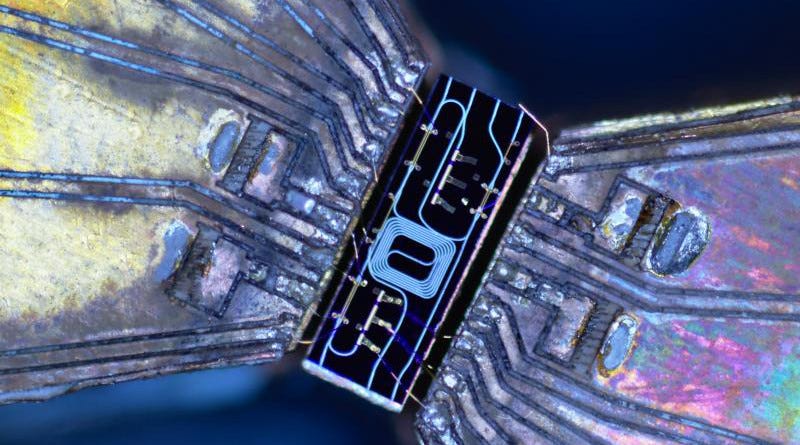With the possible arrival of the quantum internet, communications have a bright future. By providing unmatched security and speed, this network of interconnected devices, which takes advantage of the special qualities of quantum physics, has the potential to transform data transmission completely. This secure communication is based on a promising technology known as Quantum Key Distribution (QKD). Thanks to QKD, secure communication on the future quantum internet appears to be greatly promising. To generate an encryption key that is unlikely to be cracked by even the strongest classical & quantum computers, it uses the concepts of quantum mechanics. This strategy may make sensitive data transmission with unmatched security possible in the future.
The emergence of 6G networks, the next generation of wireless technology, further highlights the need for robust security solutions. As 6G promises an era of interconnected devices and advanced applications, the potential vulnerabilities of current encryption methods become a growing concern. Here, QKD presents itself as a potential solution. While still in its early stages of development, it offers the ability to safeguard communication within 6G networks. However, it's important to acknowledge that the practical implementation of QKD, particularly for certain modalities, remains an area of active research.
1. QKD Fundamentals: Harnessing the Power of Quantum Mechanics
Quantum Key Distribution (QKD) leverages the unique properties of quantum mechanics to establish a secure key for encryption, offering a potential solution to the growing challenge of securing data in the digital age. Let's delve into the core principles that make QKD so powerful:
Exploiting Quantum Properties:
Unlike classical bits that are either 0 or 1, quantum mechanics offers a more fascinating reality. Qubits, the fundamental unit of information in the quantum world, can exist in a state of superposition, being both 0 and 1 simultaneously. Additionally, quantum mechanics allows for entanglement, where two qubits become linked in a way that their fates are intertwined. These unique properties play a crucial role in QKD:
Superposition: In QKD, Alice (the sender) transmits quantum particles, like photons, in a superposition state. This means the particles are neither purely 0 nor 1 until measured, creating an inherent layer of security.
Entanglement: In some QKD protocols, Alice and Bob (the receiver) share entangled pairs of photons. If an eavesdropper (Eve) tries to intercept these entangled particles, it disrupts the entanglement and alerts Alice and Bob, ensuring the key remains secure.
Unbreakable by Quantum Computers:
The security of QKD stems from the inherent fragility of quantum states. Measuring a qubit forces it to collapse into a definite state (0 or 1). This very act of measurement introduces a level of disturbance that can be detected. Even quantum computers, which rely on manipulating data with parallelism, cannot exploit these quantum properties to break the key.
2. The Need for QKD in 6G Networks: Securing the Future of Communication
The horizon of communications technology is set to expand with the arrival of 6G networks. These next-generation networks promise to revolutionize connectivity by offering significantly faster data speeds, ultra-low latency, and the ability to connect a vast number of devices. 6G has the potential to unlock a new era of applications, from immersive virtual reality experiences to real-time remote surgery and interconnected smart cities.
However, with such communications demands comes a heightened need for robust security solutions. The rise of new technologies and the ever-growing number of devices exchanging sensitive information necessitate a secure communication infrastructure. Traditional encryption methods, while still valuable for many applications, face a significant challenge: the potential threat of quantum computers.
Quantum computers, harnessing the principles of quantum mechanics, have the theoretical capability to break the encryption algorithms that currently safeguard our data. This vulnerability could have disastrous consequences, jeopardizing everything from financial transactions to national security secrets.
Here, Quantum Key Distribution (QKD) emerges as a potential solution. Unlike traditional encryption methods, QKD relies on the fundamental laws of quantum mechanics to establish a secure key for encryption. This key, generated through the exchange of quantum particles, is inherently unbreakable by even the most powerful classical computers, including those of the future. QKD offers the promise of "unconditional security," meaning it cannot be compromised by any known technological advancement.
Therefore, QKD presents itself as a crucial technology for securing communication in future 6G networks. Its ability to provide unbreakable encryption, even in the face of potential threats from quantum computers, paves the way for a secure and reliable future for communication.
3. QKD Technologies for 6G: Building a Secure Network Infrastructure
While QKD offers the promise of secure communication, implementing it within 6G networks requires a closer look at the specific technologies involved. Here, we explore various QKD technologies with potential applications in 6G:
1. Fibre-Based QKD: The Established Backbone
Fiber-optic cables offer a mature and reliable platform for QKD implementation. This well-established technology excels in high-rate and long-distance secure key distribution. Its suitability makes it ideal for the core network of 6G, where high-bandwidth data transfer and secure communication are crucial. Fiber-based QKD systems are commercially available and can be readily integrated into existing infrastructure, offering a robust solution for secure communication across long distances.
2. Free-Space QKD: Taking Security Wireless
The 6G vision extends beyond traditional terrestrial networks, encompassing aerial and satellite connections. To ensure security in this wireless landscape, Free-Space QKD (FSO-QKD) emerges as a potential solution. FSO-QKD utilizes light pulses transmitted through the atmosphere to distribute quantum keys. This technology holds promise for providing wireless, secure key distribution for the 6G wireless access network, connecting base stations to user devices.
Implementation Methods:
Free-Space Optics (FSO): This approach utilizes lasers for transmitting quantum key information over short to medium distances.
Visible Light Communication (VLC): VLC leverages light-emitting diodes (LEDs) for secure key distribution, particularly suitable for indoor environments.
3. Emerging Technologies: A Glimpse into the Future
While FSO-QKD and fiber-based solutions are promising, research and development continue to advance QKD technologies:
THz (Terahertz) QKD: This technology utilizes terahertz waves, offering the potential for higher data rates and longer transmission distances compared to traditional FSO-QKD. However, THz QKD is still in its early stages of development.
Chip-based QKD: This emerging technology aims to miniaturize QKD systems onto microchips, paving the way for compact and potentially more cost-effective solutions. Chip-based QKD holds promise for future deployments in mobile devices and other integrated systems.
The Road to Seamless Integration:
It's important to note that for a truly secure 6G network, QKD systems need to be compatible with the network's 3D architecture. This includes seamless integration with terrestrial networks, aerial platforms, and satellites. Additionally, compatibility with other emerging technologies in 6G, such as reconfigurable intelligent surfaces and full duplex communication, will be crucial for a robust and secure future.
4. Challenges and Future Developments: Building a Robust QKD Ecosystem

Challenges:
Limited Range of Free-Space QKD: Current FSO-QKD implementations face limitations in transmission distance due to factors like weather conditions and atmospheric turbulence.
Emerging Technology Maturity: Technologies like THz QKD and chip-based QKD are still in their early stages of development and require further research to achieve practical implementation within 6G networks.
The Road Forward: Overcoming Challenges
These challenges are actively being addressed by the research community:
Extending Free-Space QKD Range: Research is ongoing in areas like advanced error correction protocols and new light source technologies to improve the range and reliability of FSO-QKD.
High-Dimensional QKD Protocols: Developing protocols that utilize higher dimensions of quantum information (beyond single qubits) holds promise for enhanced security and potentially higher data rates in QKD systems.
Maturing Emerging Technologies: Continued research and development efforts are focused on overcoming technical hurdles and making THz QKD and chip-based QKD commercially viable solutions for future 6G deployments.
5. The Road Ahead: Integration and Security—Building a Quantum-Secure Future
The true potential of QKD lies in its ability to establish a secure foundation for communication within a broader quantum internet. For 6G networks to achieve end-to-end secure communication, seamless integration with the quantum internet becomes crucial. This integration would allow users to leverage the security benefits of QKD across the entire network, from core infrastructure to user devices.
A Network of Secure Segments: Combining QKD Technologies
Given the diverse nature of 6G networks, a combination of QKD technologies might be necessary for comprehensive security. Here's a potential scenario:
Fibre-optic cables provide the backbone for secure key distribution within the 6G core network, utilizing the established strengths of fiber-based QKD for high-bandwidth and long-distance communication.
Free-Space QKD (FSO/VLC): For wireless access networks, FSO-QKD employing lasers (FSO) or LEDs (VLC) could be used to distribute secure keys between base stations and user devices. This approach is particularly suitable for shorter-range wireless communication.
Hybrid Security: QKD and Post-Quantum Cryptography (PQC)
The security landscape is constantly evolving. While QKD offers unparalleled security against current threats, the field of quantum computing continues to advance. A hybrid encryption scheme utilizing both QKD and Post-Quantum Cryptography (PQC) is envisioned to ensure future-proof security.
PQC algorithms are designed to resist attacks from even the most powerful quantum computers. By combining QKD for present security with PQC for future threats, 6G networks can achieve a comprehensive and robust security posture. This layered approach offers unparalleled protection for sensitive data transmission within the quantum era.
Conclusion
This edition of "The Road to the Quantum Internet Era" has unveiled the critical role of QKD in securing future communication networks, particularly within the framework of 6G. As we delve deeper into the quantum realm, it becomes evident that QKD is just one facet of a much larger, transformative landscape.
Upcoming editions will explore the broader implications of the quantum internet, including its potential to revolutionize fields such as medicine, materials science, and artificial intelligence. We will delve into emerging concepts like blind quantum computing, which promises to enhance privacy and security, and distributed quantum computing services, which could democratize access to quantum computational power. By engaging with global experts and industry leaders, we aim to paint a comprehensive picture of the quantum internet's potential and the challenges that lie ahead.
Our journey to unlock the full potential of this groundbreaking technology is just beginning. Stay tuned for exciting insights and developments as we navigate the complex and exhilarating path to the quantum internet era.
Key Resources & References
Alléaume, Romain, et al. "Using quantum key distribution for cryptographic purposes: a survey." Theoretical Computer Science 560 (2014): 62-81.
Liao, S.‐K., et al.: Long‐distance free‐space quantum key distribution in
daylight towards inter‐satellite communication. Nat. Photonics 11(8),
509–513 (2017). https://doi.org/10.1038/nphoton.2017.116
Tsai, C.‐W., et al.: Quantum key distribution networks: challenges and
future research issues in security. Appl. Sci. 11(9), 3767 (2021). https://
doi.org/10.3390/app11093767
Huang, Xu, Shirantha Wijesekera, and Dharmendra Sharma. "Implementation of quantum key distribution in Wi-Fi (IEEE 802.11) wireless networks." 2008 10th International Conference on Advanced Communication Technology. Vol. 2. IEEE, 2008.
Mehic, M., et al.: Quantum key distribution: a networking perspective. ACM Comput. Surv. (CSUR) 53(5), 1–41 (2020). https://doi.org/10.1145/3402192
============================================================================
If you want to partner with or support us, please reach out to me with your goals on LinkedIn; Abdulmalek Baitulmal.
Sign up now for our Newsletter so that you will never miss out on quantum tech news, updates, events, and opportunities.
AbdulMalek Baitulmal | President | OneQuantum Libya
============================================================================
Let’s take a moment to get to know some of Libyan landscapes;
Waw an Namus
Waw an Namus (also spelled Wau-en-Namus, Arabic: واو الناموس) is a volcano in Libya. Of either Pleistocene or Holocene age, it is located within the eastern Fezzan region. The origin of the volcanism there and at Al Haruj farther north is not clear. Radiometric dating has yielded an age of about 200,000 years, but other circumstantial evidence points to a formation of the volcano during Holocene or even historical times.
Waw an Namus is characterized by a caldera surrounded by an apron of dark tephra, which has a notable colour contrast to the surrounding desert terrain of the Sahara. A smaller crater lies northwest of the Waw an Namus caldera. The caldera itself contains a scoria cone. Several small lakes and associated vegetation are located within the caldera.








